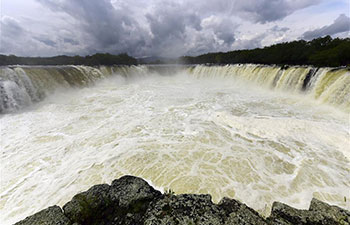WASHINGTON, Aug. 29 (Xinhua) -- An international team of astronomers from Japan, Mexico and the United States obtained the most accurate anatomy chart of a monster galaxy 12.4 billion light-years away, revealing a highly unstable molecular clouds that led to runaway star formation.
The study published on Wednesday in the journal Nature reported that an instrument called AzTEC installed in Chile had achieved 10 times higher angular resolution than ever before for an extreme starburst galaxy. Those galaxies are thought to be one ancestor of massive galaxies like the Milky Way in today's universe.
"A real surprise is that this galaxy seen almost 13 billion years ago has a massive, ordered gas disk that is in regular rotation instead of what we had expected, which would have been some kind of a disordered train wreck that most theoretical studies had predicted," said the paper's co-author Yun Min, professor of astronomy at University of Massachusetts Amherst.
According to the study, the gas disk is dynamically unstable now, which means the entire gas disk that makes up this galaxy is fragmenting and undergoing a gigantic episode of starburst, which helps to explain its enormous star formation rate, more than 1,000 times that of the Milky Way galaxy.
The researchers used Atacama Large Millimeter/submillimeter Array (ALMA)'s high resolution and high sensitivity to observe the galaxy and obtain a detailed map of the distribution and the motion of the gas to make the highest resolution molecular gas map of a distant monster galaxy ever made.
"We found that there are two distinct large clouds several thousand light-years away from the center," said Kenichi Tadaki, lead author of the paper and a postdoctoral researcher at the Japan Society for the Promotion of Science.
"In most distant starburst galaxies, stars are actively formed in the center. So it is surprising to find off-center clouds," said Tadaki.
With the new observations, the researchers found that the monster galaxy was powered by "an extremely gas-heavy disk that is somehow kept stable until enough gas is amassed," according to Yun.
"We still don't know yet how so much gas is collected so quickly and what kept this enormous gas reserve from igniting and turning into stars, as gas is known to do in the local universe," said Yun.
Also, why the gas in galaxy so unstable is not clear yet, but a phenomenon called "galaxy merger" is a possible cause. Galaxy collision may have efficiently transported the gas into a small area and ignited intense star formation.
"At this moment, we have no evidence of merger in this galaxy. But by observing other similar galaxies with ALMA, we want to unveil the relation between galaxy mergers and monster galaxies," said Tadaki.















